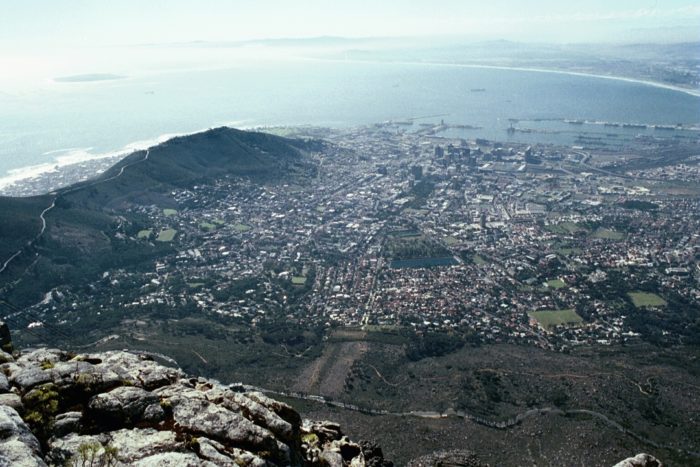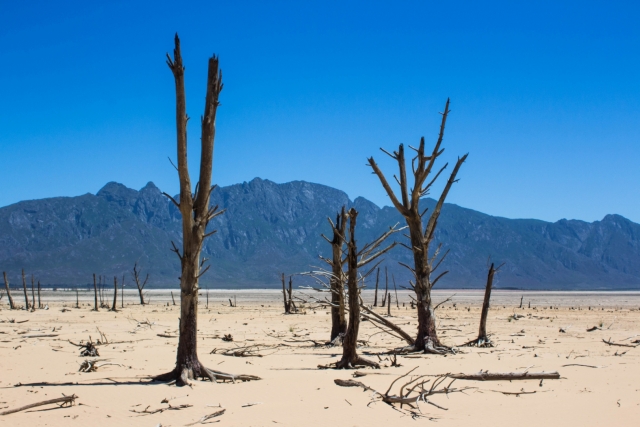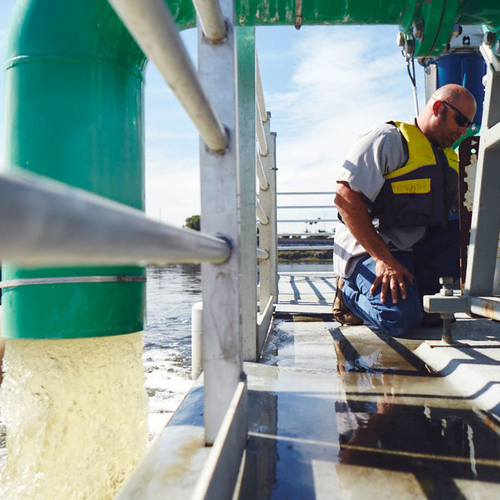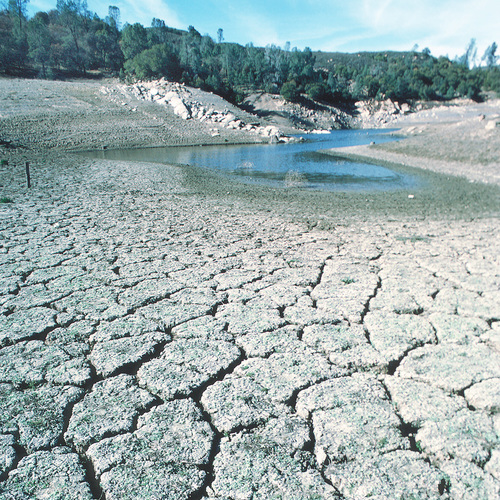
This post originally appeared at Yale Environment 360.
Backed by the iconic Table Mountain, Cape Town, South Africa’s second-largest metropolis, seduces increasing numbers of international travelers. Its charismatic neighborhoods, bright beaches, and breathtaking natural landscapes garner shelves-full of tourism awards and terabytes of glowing Instagram posts.
Recently, Cape Town also has become infamous as the home of “Day Zero,” the day when most of the city’s taps are predicted to run dry. With its major, rain-fed supply dams dangerously low after three years of drought, most of the city’s 4 million-plus residents — some rich, many desperately poor — have been facing the prospect of lining up at emergency water distribution points to collect a daily ration of just 6.6 gallons per person sometime before June or July. That’s when winter rains normally begin filling the reservoirs of this Southern Hemisphere city.
Now, largely thanks to radical conservation efforts — in January, the average Cape Town resident’s daily water quota was just one-third the amount used by the typical Californian at the height of that state’s 2016 drought — the city has reduced water consumption by 57%. Day Zero has been pushed back to July 9. And if the citizens of Cape Town (myself among them) continue to save as we have been, we should make it to the winter rainy season without having to line up for water.
So, disaster averted? Nothing to see here anymore? Far from it. The city’s efforts on the supply side of the water equation have been far less successful than its work on consumption. Even if the drought comes to an end in 2018 — and few experts are willing to predict that — the effects of this water crisis will be felt for years, possibly decades.
How did Cape Town get in this jam?
Cape Town’s predicament provides a global warning about the difficulty of ensuring water resilience in a warming world, even if, as with Cape Town, climate change is firmly on the agenda of city managers. Most climate models predict that the Cape Town region will become not only warmer, but drier, which bodes ill for a metropolitan area whose population has roughly doubled to 4 million in the past three decades and continues to grow at 1% to 2% annually.
And Cape Town’s rushed efforts to boost water supply by tapping into aquifers, including some in national parks and provincial nature reserves, are damaging valuable ecosystems and putting rare species at risk of extinction. The agricultural sector, including the Cape region’s world-renowned wine industry, has been forced to sharply cut back on irrigation, which is reducing production and leaving tens of thousands of people out of work.
So how did Cape Town, one of the best-managed and wealthiest cities in Africa, find itself on the brink of running dry? The city has, after all, won awards for its work on climate change. South Africa has some of the world’s most detailed, progressive water laws and deep expertise in water science and management, climate science, and meteorology. The city has mapped projected sea level rise and convened countless climate change adaptation planning sessions. Last year, Cape Town’s mayor said, “We cannot plan anything without factoring in the impact of climate change.”
A simple (and perhaps simplistic) answer to the cause of the current crisis is that rainfall was well below average for three years in a row, that no one could have or did predict that, and thus serious action to reduce water consumption — which should have begun in 2016 — came too late. The crisis has exposed significant weaknesses in scientists’ ability to forecast weather on a seasonal scale, which is when it matters to city managers and farmers, and predict rainfall on an annual or decadal scale, which is when it matters to developers of large-scale infrastructure, such as raising dam heights and building desalination plants.
Circumstances are considered very rare
The southwestern part of South Africa has a Mediterranean climate much like the central coast of California, with hot, dry summers and cool, rainy winters (June through August.) The winter rains fill the six large dams around the city that form the core of the Western Cape Water Supply System (WCWSS), which services the vast majority of the city’s residential and industrial water users, as well as farming areas and smaller towns nearby.
The winter rains are generally very reliable. Using historical rainfall data, Piotr Wolski of the Climate Systems Analysis Group at the University of Cape Town has determined that a multi-year drought as severe as the current one would only be expected once every few hundred years, perhaps less than once in a millennium.

In addition to historical data pointing to the extremely low likelihood of 2017’s winter being dry, the South African Weather Service modeled a three-month seasonal forecast for the winter of 2017 that predicted higher than average rainfall. Notwithstanding that seasonal rainfall forecasts for the Cape region are notoriously unreliable, it appears that officials were left feeling less urgency to impose hugely unpopular water restrictions or push forward with expensive water infrastructure projects early in the year.
Experts have long warned that Cape Town would find itself in a water crisis caused by converging drought, population growth, and the failure to secure new water resources. But because of uncertainties in water consumption rates and in weather and climate prediction, it’s been hard to fix a date.
“Water security has always been seen as ‘important’ in Cape Town, but until recently it has not been seen as ‘urgent,’” says Christine Colvin, head of freshwater programs with WWF-South Africa. “We have an HIV/AIDS epidemic, an education crisis, massive unemployment — these are understandably ‘urgent’ to politicians and have competed successfully for attention and funding. Add to this South Africa’s fractured government institutions, corruption, and the fact that the national government is responsible for bulk water infrastructure like dams, but municipalities are responsible for water distribution and demand management, and you have a recipe for inaction on major water projects.”
In addition, Colvin says, the City of Cape Town raises significant revenue from water sales to residents, so it has never seriously incentivized individuals to conserve.
Aggressive action came last year
But as the magnitude of the growing water shortage became clear last year, Cape Town officials responded with an aggressive conservation campaign. Last June, all use of municipal water outside the home was banned, meaning no car washing or garden irrigation. In September, residents were limited to 23 gallons per person per day for all uses (washing, drinking, and toilet-flushing included) and at the beginning of February this year, the daily personal quota was reduced to a mere 13 gallons. Water pressure has been reduced across the city, slowing the flow from residents’ taps. And the municipality has installed tens of thousands of water-restriction devices on high-use households and has sharply increased punitive water tariffs for heavy users.
As a result of these and other measures, the city’s water consumption has fallen from 317 million gallons per day in early 2015 to about 137 million gallons per day. Day Zero has been pushed back from April 12 to July 9.
Cape Town is now scrambling to augment its rain-fed dams with other sources, mindful that a further year of drought is not impossible. Government has identified various options, including desalinating seawater, reclaiming wastewater (i.e. purifying sewage, as is successfully done in some other cities), and tapping underground aquifers. But desalination plants are expensive to build and operate, wastewater treatment plants are time-consuming to construct, and so the city has prioritized the hasty drilling of dozens of boreholes. Many of the drilling sites are in protected areas that are government-owned, which simplifies access.
Drilling boreholes and constructing pipelines, especially in conservation areas, would usually require environmental impact assessments and detailed environmental management plans. Because of the drought emergency, however, the provincial government has significantly relaxed these requirements, to the increasing concern of biologists and conservationists.
Rare plants abound, pressure for new wells intense
Cape Town is situated in the heart of the Cape Floristic Region, a distinct area of extraordinary biological diversity that contains 9,500 species of plants, about 70 percent of which are endemic. The Cape Floristic Region’s dominant vegetation type, popularly known as fynbos, contains many noteworthy species that are descended from ancient lineages. “These plants are like the Mona Lisas, the Rembrandts of the botanical world,” says William Bond, a botanist at the University of Cape Town.
Many of these plants are also dependent on seeps — permanently wet areas where underground aquifers naturally spill out on to the surface. Some are so rare that they only occupy single, tiny sites. “Drilling a single borehole in the wrong place could cause the extinction of a species,” says Bond.

It may already be too late for the Wemmershoek Erica (Erica bakeri), a diminutive heath-like plant with tiny pale-pink, bell-shaped flowers. About two weeks ago, the rushed construction of a water borehole and a pipeline trench commissioned by the municipality of Stellenbosch severely damaged a wetland in a conservation area. The wetland is the last known habitat for the Wemmershoek Erica, and one of the last known habitats for other critically endangered plants. “Goodbye… How many thoughtless flushes were you worth?” tweeted Cape Town ecologist Jasper Slingsby.
Notwithstanding the environmental impacts, there is enormous political pressure to proceed with borehole drilling. Biologists with the provincial nature conservation agency, CapeNature, have been forbidden to speak to the media. Nonetheless, documentation of environmental harm is leaking out: a spill of drilling mud that fouled a long section of a pristine river; maps showing more than 200 planned borehole sites in ecologically sensitive areas; and consultants’ reports showing drilling foam and toxic pump-test water spilling into nature reserves.
“We shouldn’t go blundering into these natural areas, but now it’s like the drillers have a blank check to do that,” says Bond.
Slingsby worries that once the boreholes are drilled, it will be politically difficult to turn them off, even if they dry up fragile wetland ecosystems. “I don’t know of any place that has given up water sources like that,” he says.
Impact in agrarian areas under-reported
Almost all the Cape Town drought media coverage has focused on the city itself. Few reporters have paid attention to the rural areas around it, enormous acreages of which are covered in economically valuable vineyards, olive groves, and fruit orchards that require irrigation from the same six large dams and associated pipelines that sustain Cape Town. Farmers in the region have had their water allowance cut 60% to 87%, meaning that almost all irrigation was halted on February 1, even as many trees still carried fruit.
The Western Cape provincial government has estimated that 50,000 agricultural jobs will be lost this year, mostly among seasonal fruit-pickers, leading to about 260,000 people requiring poverty-relief assistance. Most of South Africa’s wheat is grown near Cape Town, and many wheat farmers will not harvest a crop this season. Agri Western Cape, a farmers’ union, says that farmers around Cape Town have lost about $1.2 billion due to the drought. Twenty-two percent of the sheep in the region have been culled because of a lack of fodder.
Francois Viljoen of Vinpro, an organization representing vine-growers and winemakers, estimates an overall harvest reduction of 15% to 25% this year. Even if good rains fall in winter, “we will see a carryover effect next growing season, with reduced yields, because the vines have not been able to build up reserves during the drought.” Because of smaller harvests, seasonal fruit-pickers will again have reduced income, with significant effects on poor rural communities.
No one can say how long Cape Town’s water crisis will last. Even if good rains fall this winter, tight use restrictions will likely remain in place indefinitely; the dams have been drawn down so far that it may take years to refill them, and water augmentation projects may take years to scale up.
The future is unknown
Longer-term, a changing climate may well add to Cape Town’s water pressures.
“The models agree that Cape Town will become hotter over the next century,” says Peter Johnston of the University of Cape Town’s Climate Systems Analysis Group. “Most of the models — but not all — predict that it will become drier, too.” Increasing the city’s water resilience will mean expanding supplies from sources like desalination plants that are not as influenced by the vagaries of rainfall as the current dams. But these are expensive and energy-intensive, and residents will pay more, perhaps significantly more, for water.
The government will have to roll out new infrastructure amid considerable uncertainty about rainfall in the coming years, running the risk of over- or under-spending. Willem Landman of the University of Pretoria says that meteorologists “can make a reliable weather forecast that works for five days” and climate scientists “can model the average climate conditions a hundred years from now with a great degree of confidence. But decadal predictions? Forget about it. We don’t know how to set the models up. We can’t say what the rainfall is going to be 10 years from now.”
The question of whether Cape Town has moved into a new, climate-changed, normal, with more frequent droughts, is not easy to answer. “We’re out of the envelope of certainty,” says Christine Colvin. “Cape Town is not special. Many other cities will face these challenges in coming years.”
Adam Welz is a South African writer, photographer and filmmaker based in Cape Town. He writes about international and African wildlife issues for Yale Environment 360.
Weekly Newsletter
Get building science and energy efficiency advice, plus special offers, in your inbox.













5 Comments
What can we learn from this?
ADAM,
Thank you for the excellent article. Can you comment on what changes were required personally in order to reduce your usage to just 13 gallons/day and how that's effected your day to day life? I'm also curious on what the flow rates are for things like the faucets, shower heads, etc are in order to keep consumption sufficiently low? Essentially, what can I do to keep my families consumption down so I can do my part to prevent this sort of thing happening in my area?
Thank you.
Edit: I found the link below which links to a PDF detailing some of the requirements. According to what I'm reading there the city's by-laws dictate a flow rate of no more than 1.59gal(6l)/minute for bathroom faucets and 2.64gal(10l)/minute for showers. Those seem like very high flow rates to me, considering the crisis being faced. I presently have 1.5gal/minute shower heads and 0.5gal/minute faucet aerators fitted in my home. Am I misreading that? Are efforts pushing household flow rates lower than the by-laws require?
http://www.capetown.gov.za/Family%20and%20home/residential-utility-services/residential-water-and-sanitation-services/saving-water-in-the-home
Cape Town isn't California
A 1.5gpm shower in CA uses a lot more water than a 2.64 gpm shower in Cape Town, under current guidelines In CA people turn it on and stand under it for about 8 minutes, give or take a few, and for less drought stricken areas in South Africa the average is closer to 9 minutes.
The guideline recommendations in Cape Town are to limit shower flow times to 2 minutes, Euro-style (wet yourself down, stop the flow, lather up, rinse.)
2m x 2.64g/m= 5.28 gallons
5.28g / 1.5gpm = 3.5 minutes.
Do you run the shower 3.5 minutes or less?
http://www.702.co.za/articles/262644/shower-for-less-than-2-minutes-as-cape-town-enters-level-4b-water-restrictions
https://ndownloader.figshare.com/files/9219172
Dana,
No, I don't, not when I'm at home. When I'm at work, at sea, we take what we call pusser showers fairly regularly. I fail to see what that has to do with what I asked.
Given the crisis they're in, two minutes with a good low flow shower head at 1.5gpm would use 2.28 less gallons per shower. Or, they could use the same amount of water but have a much more enjoyable 3.5 minute shower. Either way if they're going to be purchasing new shower heads why not go lower than just a standard 2.5gpm shower head? For all of the amazing work that they've done, it seems like they're taking a half measure there. Is the water pressure so low that a low flow shower head wouldn't give an effective shower? Are they not available in that region for some reason?
Water use and flow limiters
Those flow ratings are just presenting a ceiling for the device. There's nothing stopping them from running the shower at less than max pressure. My shower head is 2 gpm but it actually feels like considerably more, so I run my shower at a lower flow than that.
They don't need to replace all the hardware in the country to use less water.
It's not that the drought couldn't or wasn't predictable..
What is lacking is governmental understanding that such risks are real, and need to be addressed BEFORE they occur. The rapid growth of the city has also adversely affected the situation.
Knowing "when" a likely disaster might come is NOT relevant to taking measures to avoid it. And ANYONE who assumes that weather predicitons today based upon historical data will be accurate is NOT actually aware of climate change.
As with the Southwestern NA, drought is a normal part of the climate--though the SW has a history of multi-century droughts that South Africa doesn't seem to have.
Long-term, we really need to rethink our water usage, sources and disposal/waste processing.
California HAD a large desalinization plant--they sold it off.
SA is well situated for such a plant, and there is no reason it couldn't be powered by solar and wave/tidal action.
Unfortunately, humans only address such issues when they kill people or otherwise make life very hard.
This is why efficient wood stoves were designed in N. Europe when forests were depleted (In England, this happened at least three times.)
It's why water usage in Europe is lower and more efficient than most of NA.
One of the main reasons governments subsidize improved efficiency of resource use is because all new tech costs more, and replacing a working system may not be cost-effective for the individual, but it is for the species.
I can go solar electric, and I will break even about the time the system needs replacing. Or I can wait ten years until the systems are more cost-effective and robust...
There's no reason to do the work unless I can do more than break even--if only because of the costs and time involved in replacement.
Discussion about flow rates is irrelevant unless you know the total water use--as several people have demonstrated.
Ideally, systems are plumbed to use grey water for flushing waste or for garden & lawn water.
One sq meter of clear plastic can purify up to a gallon per day under the most primitive situations--and is a perfect fit for places like south India where the groundwater is saline--and clear plastic sheeting is a worldwide industrial waste issue.
I strongly suspect that the city is not taking sufficient precautions in preparing for climate change, if only because the vast majority of forecasts are optimistic in the extreme--few predict more than a few centimeters of sea level rise within a decade, and very few acknowledge that the rise is not a smooth curve, but will contain some short periods of rapid rise--as much as 1m/year or more.
Log in or create an account to post a comment.
Sign up Log in